-
November 16, 2016 by Total Fire and Safety
Your fire risk is very diffe rent on Thanksgiving Day than it is on any other day of the year. Residential fires are a lot more common, because everyone is cooking! Here are some fire safety facts about Thanksgiving Day that you should be aware of, and some safety tips to remember so you don’t become a part of these statistics. rent on Thanksgiving Day than it is on any other day of the year. Residential fires are a lot more common, because everyone is cooking! Here are some fire safety facts about Thanksgiving Day that you should be aware of, and some safety tips to remember so you don’t become a part of these statistics.
- From 2011 to 2013, there was an estimated 2,100 cases of residential fires per year and approximately 10 deaths, 50 injuries, and $28 million in property loss, according to the National Fire Protection Association.
Be thankful for the chance to be mindful of fire safety at Thanksgiving!
- Most residential fires happen in single family homes, 65 percent, or multifamily homes, 28 percent. A fire could happen in your own neighborhood, or even your own home.
Be thankful for all the working fire extinguishers and smoke detectors in kitchens across the country!
- The peak time for frequency of fires was from noon to 3 p.m., the time when many people are working on preparations for the big meal. This differs from normal days, when residential building fires are most likely to occur during the dinner hours of 5 p.m. – 8 p.m.
Be thankful for properly attended stoves as we prepare the Thanksgiving meal!
- Of all Thanksgiving Day fires surveyed, 73.5 percent were limited to the object of origin; 11.6 percent limited to the room of origin; and 10 percent limited to the building of origin.
Be thankful for knowing how to operate a fire extinguisher to stop a fire before it causes too much damage!
- The majority of fires on Thanksgiving Day are caused by cooking, at 72 percent. Practice safe cooking by checking temperatures frequently, being extra careful with open flames and ovens, and not overcrowding the kitchen.
Be thankful for cautious holiday cooks who observe fire safety measures!
There is one last reminder that turkey lovers should keep in mind this year. Deep frying turkeys is a tradition for some Americans, but it is also a dangerous fire hazard. Watch this video to see a fiery demonstration of what can go wrong if you deep fry a turkey unsafely.
Be thankful for deep frying with caution and care!
Total Fire & Safety wishes you a happy holiday! If you are interested in a kitchen suppression system, safety inspection, or fire extinguisher training in preparation for Turkey Day, contact us at 630-960-5060.
Category: Fire Safety, Total Fire and Safety, Trends Tags: fire safety, holiday fire safety, thanksgiving fire safetu, thanksgiving fire safety, thanksgiving fire statistics, thanksgiving safety | Comments Off on Thankful Fire Safety Facts for 2016
-
October 24, 2016 by Total Fire and Safety
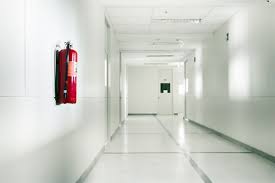 National Fire Prevention Week has been a yearly campaign since 1922, occurring on the Sunday through Saturday period that includes the date October 9. It was established to commemorate the Great Chicago Fire on October 8-9, 1871. This infamous tragedy claimed 250 lives, destroyed more than 17,400 structures and left 100,000 people homeless. Fire prevention week is a day to remember this event and also what kind of effect a fire could potentially have on our lives. National Fire Prevention Week has been a yearly campaign since 1922, occurring on the Sunday through Saturday period that includes the date October 9. It was established to commemorate the Great Chicago Fire on October 8-9, 1871. This infamous tragedy claimed 250 lives, destroyed more than 17,400 structures and left 100,000 people homeless. Fire prevention week is a day to remember this event and also what kind of effect a fire could potentially have on our lives.
No matter what kind of business you own or manage, October is also the perfect time to remember how devastating fire can be, and how important it is to be ready for an emergency. A fire can cause serious damage to your company’s facility and equipment, not to mention employees! This is as good a month as any to make sure you have these five ‘checks’ taken care of within the boundaries of your office and/or facilities.
1. Are your fire hazard risks assessed properly? Some businesses have greater fire risks than others, but there are very few businesses that have none. They all need to be properly assessed so the proper prevention can be implemented accordingly. Some local governments offer fire marshal visits, or workplace fire risk assessment guidance from your building’s property manager. A commercial fire safety firm can also help you mitigate problems.
2. Do you have emergency plans in place? Do you have an evacuation plan and do your employees know what to do in case of a fire? Do they fire training, so that they know how to use fire extinguishers, and when to use them?
3. Do you have the right fire protection equipment installed? Your fire safety equipment needs likely include sprinkler systems, but you might need more to be up to code or compliant with regulations. Industries dealing with machinery that overheats or flammable substances might need a suppression system tailored to your business.
4. Do you have scheduled routine equipment inspections? Even if you have the right sprinkler systems, fire extinguishers, and suppression systems, they also need routine inspections (at least annually) to keep everything in working order. Know what tests you can do yourself, and which require professional visits from fire alarm technicians.
Even though Fire Prevention Week is over, it’s not too late to think about your fire prevention and safety. Perhaps now is the time to take action. Contact us or call 1.630.960.5060 for more information on any of the fire steps detailed above, from alarm installation to employee training programs.
Category: Fire Alarm Monitoring, Fire Extinguishers, Fire News, Fire Safety, Sprinkler Systems, Total Fire and Safety Tags: commercial fire prevention, fire extinguisher regulations, fire prevention, fire prevention for businesses, fire prevention week, fire week, national fire prevention week | Comments Off on How Is Your Company’s Fire Prevention? Four Questions for Business Owners!
-
October 12, 2016 by Total Fire and Safety
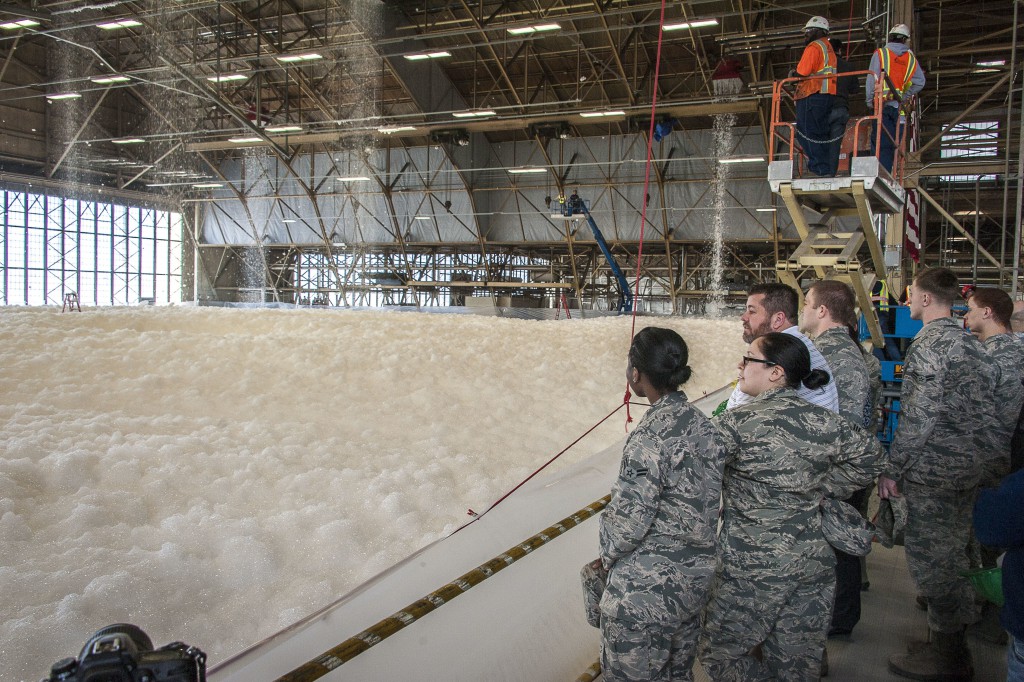
Recently, a viral youtube video was released by the Daily Military Defense & Archive. It shows an activated fire suppression system that can fill an aircraft hangar with foam in two minutes, covering at least 90 percent of the aircrafts with a simple, water-based foam. For the average Joe, it’s a visual spectacle to see that amount of space quickly fill with thick white foam and then get to witness the cleanup process (involving huge big squeegees) afterwards. Luckily, these systems usually trigger by accident or for a test run, and there aren’t a lot of cases where the system is triggered because danger is imminent. The government is successfully using this fire protection system to protect aircraft inside military hangars around the world.
This video is a great example of how suppression systems work quickly and effectively. They can be deployed with amazing speed, and for a government building of this size and caliber, this system could save countless employee lives and millions in property damage.
The suppression systems offered and maintained by Total Fire & Safety are not quite as messy as the ones in the video, but they are similar in many ways. The kitchen suppression systems we install for you are designed for specific type of fires that often occur around cooking equipment, whereas the suppression systems in an aircraft hangar are designed to fight fires caused by equipment failure or aircraft fuel. Rest assured that the suppression system in your commercial kitchen won’t fill the room with foam, but it will still get the job done in an emergency!
Do you have a suppression system in place at your business? Total Fire and Safety has suppression systems that can protect your people and your assets. For more information about suppression systems, contact Total Fire & Safety at 630-960-5060.
Category: Fire News, Fire Safety, Suppression system, Trends Tags: epic fail, Fire Extinguisher, fire news, fire safety news, fire suppression system, fire system, foam, foam suppression system, hangar foam, military fire suppression, Suppression System | Comments Off on Have You Got the Power? Of a Suppression System?
-
September 20, 2016 by Total Fire and Safety
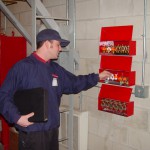
Since they don’t wear a cape or colorful tights, to the untrained eye the fire alarm technician is just the guy who comes in to check the safety of your fire equipment. But in reality, the fire alarm technicians at Total Fire & Safety are specialized employees who actually end up saving lives by making sure your equipment functions properly in an emergency situation at your commercial building!
Yet these humble heroes walking among us in a simple Total Fire & Safety uniforms often go unappreciated because people don’t understand the special powers they possess and bring into play on a daily basis. For example, all Total Fire & Safety fire alarm technicians…
1. Battle the forces of evil at a moment’s notice! When the call comes, the fire alarm technicians jump in their “Total Firemobile” and rush bravely in to battle the villain, whether it’s a malfunctioning backflow problem or a damaged sprinkler system. They soundly thwart the forces of equipment failure by repairing and replacing the critical systems, always emerging victorious. While Chicagoland sleeps, the Total Fire & Safety technician is on the job, throughout greater Chicagoland, lndiana and lower Wisconsin. 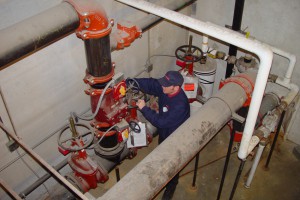
2. Excel at searching out the right clues to every puzzle. The crafty fire alarm technician can decode the secret language and uncover the valuable clues in blueprints, diagrams, specifications, schematics and operational/product manuals to find the information that saves the day and restores equipment to its proper functionality. It’s all in a day’s work for the fire alarm technician!
3. Protect their customers and save the day. The Total Fire & Safety fire alarm technician deals directly with our customers, listening to their needs and providing the best, safest solutions for their situation. With professionalism and skill, they communicate with headquarters to make sure all is well for their customer, humbly accepting a mere humble thanks for their efforts.
4. Go wherever the wind takes them…even overnight. The life of a fire alarm technician is filled with adventure on the road, going where they are called and serving willingly. Total Fire & Safety fire alarm technicians are flexible enough to travel overnight in order to perform inspections and repairs for clients that are not so close by. That’s what all heroes do!
Bravery, trustworthiness and competence are all marks of the highly trained fire alarm technicans at Total Fire & Safety. Do you have what it takes? We are always looking for skilled individuals to join our force of heroes. Those who qualify can apply at apply at Total Fire & Safety for a distinguished career as well as competitive compensation and benefits such as health and dental and a position in a growing company with room for advancement. Contact Total Fire & Safety today about opportunities and learn how being an everyday hero with us can lead to exciting opportunities to do good in the world!
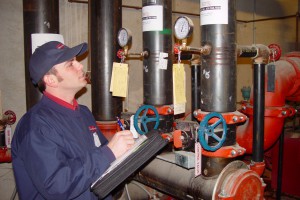
Category: Fire Alarm Monitoring, Fire Extinguishers, Fire Safety, Sprinkler Systems, Suppression system, Total Fire and Safety Tags: fire alarm, fire alarm for business, fire alarm tech jobs, fire alarm technician, fire alarm technician jobs, fire safety, fire safety careers, fire safety jobs, technician jobs, Total Fire & Safety, total fire & safety jobs, Total Fire and Safety, total fire and safety jobs | Comments Off on The Fire Alarm Technician: Not All Superheroes Wear Capes!
-
August 17, 2016 by Total Fire and Safety
If you are an employer with ten or more employees, you are probably aware that OSHA requires you to conduct fire safety training and first aid training for your employees. But what is the value of this safety training? Does it really make a difference, or is it just a technicality?
The fact is, different ki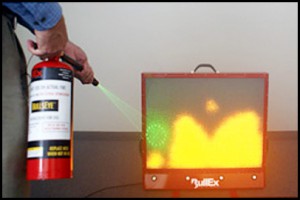 nds of occupational injuries and accidents, including fire safety ones, cost companies thousands and even millions of dollars a year. These include the direct costs of property damage and employee injury as well as the indirect costs of production down time and the intangible profitability loss from the lingering emotional effect on the morale of the employees. If you’ve ever wondered what that dollar amount would be for an injury at your jobsite, OSHA developed a calculator tool that you can use to see the cost of an injury at your business. As an employer, you are liable for the injuries or accidents that happen in your workplace, so making sure your employees are properly trained can save you money. nds of occupational injuries and accidents, including fire safety ones, cost companies thousands and even millions of dollars a year. These include the direct costs of property damage and employee injury as well as the indirect costs of production down time and the intangible profitability loss from the lingering emotional effect on the morale of the employees. If you’ve ever wondered what that dollar amount would be for an injury at your jobsite, OSHA developed a calculator tool that you can use to see the cost of an injury at your business. As an employer, you are liable for the injuries or accidents that happen in your workplace, so making sure your employees are properly trained can save you money.
The American Society of Safety Engineers (ASSE) has gathered extensive data on the effectiveness of quality safety training programs, and the results are promising. Some of their findings include:
- OSHA estimates that companies that implement effective safety programs can expect reductions of 20% or greater in injury and illness rates, as well as a return of $4 to $6 for every $1 invested in the programs.
- Workplace injuries will cost society $128 billion in losses this year, which equals one-quarter of each dollar of pre-tax corporate profits
- Indirect costs of injuries may be 20 times the direct costs — Indirect costs include: training and compensating replacement workers; repairing damaged property; accident investigation and implementation of corrective action; scheduling delays and lost productivity; administrative expense; low employee morale and increased absenteeism; poor customer and community relations
- Conducting effective safety training has been proven to lower your Workplace Modification Factor, which insurance companies use to assess businesses and determine their rates.
All in all, studies have proven that safety training programs can save your business money and grief. More ASSE reports on the returns on safety training investment can be found here.
The best safety training programs will be tailored to the type of injuries or accidents your employees are most likely to encounter. This is especially true in the realm of fire safety training, where different companies will need to know different things about the fires they are most likely at risk for in their working environment. As a result, all fire safety and first aid training programs are not alike. Choose the best fire safety training program or first aid training program for your company.
For more information on the specific needs of your business and how to achieve OSHA standards at a practical price, contact your local OSHA consultation office. Offering the right fire safety training and first aid training courses that prevent injuries will empower your employees to handle emergency situations well and prevent potentially fatal injuries. Don’t fail them! Look into Total Fire & Safety training today! For more information, contact Total Fire & Safety at 630-960-5060.
Category: Fire Extinguishers, Fire Safety Tags: Fire Extinguisher, fire extinguisher programs, fire extinguisher safety training programs, fire extinguisher training, fire safety training, first aid training, good fire training programs, OSHA fire training, safety training programs | Comments Off on How Fire Safety Training Pays
-
July 11, 2016 by Total Fire and Safety
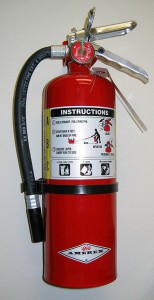
In light of the horrific recent events of random shootings in public places, most people can’t help but wonder about their own self-defense and how they would handle such a situation unarmed. Just imagine if you could protect yourself from a public shooting with a non-lethal weapon just hanging on the wall, possibly within arm’s reach.
You can, with a fire extinguisher.
Most people wouldn’t think of using a fire extinguisher for self-defense, but actually, dry chemical fire extinguishers make good non-lethal weapons. What happens if you shoot a fire extinguisher at an attacker? It can slow, stop or incapacitate them depending on how close you are to the target, because the dry powder fire extinguishers shoot their streams at high speeds. The stream travels for 12 to 20 feet, and covers an area considerably larger than that of pepper spray. The chemical stream can get into the attacker’s nose, mouth, and eyes. The attacker will try to clean their face and this diversion could buy enough time to disarm them and save lives.
Random shooters are often unprepared for a person to fight back, and the range of the fire extinguisher can create a cloud to obscure the area and diffuse the situation. Fire extinguishers are always around, in a convenient location, ready to use. They are easy to operate, and easy to find in public places where other weapons are not available or are banned (like in the case of schools). It’s a good idea to get familiar with fire extinguishers.
To be clear, we are not advocating using fire extinguishers as a weapon outside of a life threatening situation. It is also definitely best to have fire safety training and experience before having to use them in self-defense. However, in a life-threatening emergency, where a weapon is needed, fire extinguishers can help. To use a fire extinguisher, remember PASS:
—Pull the pin. Hold the extinguisher with the nozzle pointing away from you and release the locking mechanism.
—Aim low. Point the extinguisher at the base of the fire.
—Squeeze the lever slowly and evenly.
–Sweep the nozzle from side-to-side.
Until we have seen the end of random violence in our country, it is important to know your options in an emergency situation. Having more fire extinguishers around can help keep you safe from more than just fires!
For more information about how you can make fire extinguishers more accessible in your home or workplace or for fire extinguisher training for emergency situations, contact Total Fire & Safety at 630-960-5060.
Category: Fire Extinguishers, Fire News, Fire Safety Tags: Fire Extinguisher, fire extinguisher as weapon, fire extinguisher self defense, gun control, gun safety, orlando shooting, public security, school shooting safety, shooter self defense | Comments Off on Fire Extinguishers as a Self-Defense Tool?
-
June 9, 2016 by Total Fire and Safety
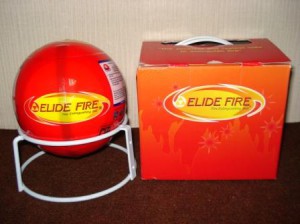 www.elidefire.com Elide Fire has a zany idea that might change the way that we fight fires in the future. These ball-shape extinguishers are like hand-held bombs that disperse the same chemicals that are found in normal fire extinguishers. To activate, you simply toss one toward the fire, and these little firefighters take care of everything. They are designed to activate within three seconds of being in contact with fire. They also work as alarms, emitting a loud sound when activated.
You may be thinking, could these really work to replace fire extinguishers as we know them? Although having red balls filled with chemicals sitting in your kitchen or near electrical plugs may clash with your color scheme, they would be able to activate even when you’re not at home. This feature could potentially save lives as well as property damage (as long as they never accidentally activate without fire, though. That would be a mess!).
The best part about this invention, however, is that it would be extremely easy to operate compared to a normal extinguisher. Using these extinguisher balls would be as simple as, well, tossing a ball. Even a child could do it (in a desperate situation, of course). Who knows, perhaps the fire training industry will soon have to create a simplified program that will more closely resemble pitching practice than fire safety training.
The Extinguisher Ball has a lifespan of five years, and is meant to be mounted or displayed in fire-prone places. Total Fire and Safety is keeping an eye on this new product for further developments, but in the meantime, those basic red fire extinguishers hanging on your wall are your best bet in the event of an actual fire. For more information on fire extinguishers and wireless fire alarms currently available, contact Total Fire & Safety at 630-960-5060.
Category: Fire Extinguishers, Fire Extinguishers, Fire News, Fire Safety, Total Fire and Safety, Trends Tags: alternative fire extinguisher, elide extinguisher balls, elide extinguishers, elide fire, Fire Extinguisher, fire extinguisher balls, fire extinguisher technology, fire fighting technology, fire news, fire rextinguisher bombs, fire safety news | Comments Off on Fire News: An Exploding Fire (Extinguisher?) Ball?
-
May 23, 2016 by Total Fire and Safety
We are live at the National Restaurant Association (#nra) at
McCormick Place here in Chicago!
 The event opened May 21 and closes tomorrow so there is still time to come down and see us. The association is expecting 42,000+ foodservice buyers with big budgets and an appetite to buy. Total Fire & Safety has a booth here to network with more businesses and get the word out about our services, especially for restaurants. With the growing need for suppression systems, service to food-serving businesses like restaurants are an expanding part of our business. Come visit us in booth #8900-9000 at this convention, and pick up some samples along the way! The event opened May 21 and closes tomorrow so there is still time to come down and see us. The association is expecting 42,000+ foodservice buyers with big budgets and an appetite to buy. Total Fire & Safety has a booth here to network with more businesses and get the word out about our services, especially for restaurants. With the growing need for suppression systems, service to food-serving businesses like restaurants are an expanding part of our business. Come visit us in booth #8900-9000 at this convention, and pick up some samples along the way!
(From left to right: Jason Schroeder, V.P. of Business Development and Marc Spinder, Outside Sales Representative are at the National Restaurant Association Show in Chicago.)

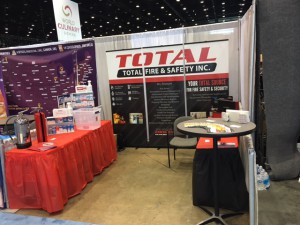
For more information,
contact Total Fire & Safety
at 630-960-5060.
Category: Fire News, Fire Safety, Suppression system, Uncategorized Tags: chicago convention, chicago fire news, chicago news, fire news, fire safety in the news, fire supression system, fire supression system news, food service industry safety, national restaurant association, NRA Show, NRA Show exhibit, NRA Show exhibitors, Suppression System, Total Fire and Safety, total fire and safety news | Comments Off on Total Fire & Safety at the #NationalRestaurantAssociation Show!
-
April 13, 2016 by Total Fire and Safety
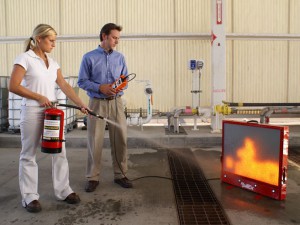
If your business has more than ten employees, they are going to need annual fire safety training. Some businesses rush to the least expensive program that will satisfy OSHA requirements, assuming that all training is the same; however, that’s simply not true. Fire safety training can vary in quality based on a number of factors, and many come with “hidden” fees that you may not be aware of. So what should you look for? Here are some important questions to ask before you book the training company.
1. What kind of course would you recommend? The course you need for your company should address the most probable emergencies that can occur at your facility. A training company worth its salt will tailor the course to your needs, surveying your business ahead of time to determine the most important content needed for your employees.
2. Who is teaching the course? Make sure the instructors are experienced professionals who know what real emergencies are like and how they occur. It’s even better if the instructor has experience with real-life emergencies. Nothing compares to the knowledge of a first responder who has faced countless fires and hazardous events. They can share personal stories, anecdotes and examples related to the training, which can make the class more interesting.
3. What will the course cover? Basic training courses cover how to use the fire extinguisher, but the most important thing employees should learn is WHEN to use the fire extinguisher. A good training course will focus on the importance of making fast and accurate, life-or-death decisions. Not only should your employees know how to fight fires, but also WHEN to fight the fire, and most importantly, when not to fight the fire. Evacuating and leaving it to the professionals is sometimes the best decision an employee can make.
4. Where will the training take place? Many fire safety trainings are performed outdoors, with a live burn in a pan that employees practice extinguishing. Although exciting, putting out a pan fire in a parking lot does not accurately simulate a realistic fire or emergency situation! Also, elements of the weather such as wind can affect the fire and unrealistically hamper the efforts of the employee trying to learn proper extinguishing techniques. It is much more effective to practice emergency procedures where they actually occur—inside the facility. With the help of digital technology, your employees can learn to extinguish the exact type of fire they would most likely face right at their worksite. This “on-the-spot” training also helps employees develop realistic evacuation plans and teach them to work as a team in an emergency situation.
5. Will there be extra costs involved with the equipment or the course materials? If the trainer is using “live burns”, or actual fires to practice extinguishing, you will need to have a burn permit and may incur any associated costs with setting up an outdoor space needed for the demonstration. If the training company uses your fire equipment for a live burn session, you will have to recharge them. You may not have budgeted for this unexpected, volatile cost, and it will vary based on how many turns each participant receives to extinguish the fire. The fire safety courses offered by Total Fire & Safety use high-tech, virtual simulators to practice extinguishing fires, which are versatile and allow more practice for each participant. These simulators feature virtual fire on a screen that responds realistically to the participant’s motions with the fire extinguisher. The indoor training gives each person multiple attempts with a full extinguisher every time until they feel confident with their firefighting skill. Compared to outdoor training, simulated training is more cost effective, accurate, completely green, and requires no messy clean-up or permit fees.
So before booking a company to perform fire safety training for your employees, ask these questions to make sure you receive your money’s worth for your employees and your business. No one can predict how an emergency will unfold, but the right training company can make sure your employees are not only prepared to fight a fire, but are adept at making quick decisions about whether or not it is safe to do so. For more information, contact the professionals at Total Fire & Safety at 630-960-5060.
Category: Fire Extinguishers, Fire Extinguishers, Fire Safety, Total Fire and Safety Tags: employee training, Fire Extinguisher, fire safety, fire safety training, fire training, fire training technology | Comments Off on Five Important Questions to Get Your Money’s Worth from Fire Safety Training
-
February 26, 2016 by Total Fire and Safety
 You may think you know the importance of first aid and fire safety, but the real impact of first aid and fire equipment training in the workplace is often overlooked. Whether your business is a high or low-risk environment, there are always risks that can lead to medical emergencies. You may think you know the importance of first aid and fire safety, but the real impact of first aid and fire equipment training in the workplace is often overlooked. Whether your business is a high or low-risk environment, there are always risks that can lead to medical emergencies.
1. Increasing profitability. A safer workplace means less missed workdays due to injuries. According to the National Safety Council, in 2012, nearly 5 million workers were injured at work, which costed employers a total of $198.2 billion.
2. Saving your employees time and money. It is proven that businesses and employees will save money if accidents are handled quickly and effectively. The National Safety Council attests that 25 percent of all emergency room visits can be avoided with basic first aid and CPR certification.
3. It really does save lives. If your employees don’t know how to handle injuries, the condition of the victim could worsen before the ambulance arrives, and cause further trauma and debilitation, not to mention medical costs and possibly, even death. Having a commercial first aid kit on the job sends a message to your employees that you value their health and well-being and are doing all you can to mitigate any injuries that occur on the job. It also shows that you never want your employees to be vulnerable to unattended injury.
4. It is required by law for many workplaces. The Occupational Safety and Health Administration requires businesses to provide first aid and CPR training to employees if there is no nearby clinic or hospital. Make sure you also have a commercial first aid kit available in your workplace. Obviously, if your business deals with risky materials or conditions, having a commercial first aid kit makes sense whether or not you are bound by law.
5. Teach your employees how to use emergency equipment. You spend money keeping your workplace up to code with commercial fire extinguishers and first aid kits, but these things don’t handle emergencies by themselves! Your employees need to know how to work fire extinguishers and use first aid supplies correctly. The investment need not be costly; a simple on-site class with the staff in attendance should suffice.
Total Fire & Safety can handle all your needs whether it be fire extinguishers, first aid kits, fire extinguisher training, or first aid training. For more information, visit our website or you can contact us at 630-960-5060.
Category: Fire Extinguishers, Fire Safety, First Aid Kits, Total Fire and Safety Tags: fire safety training, fire training, first aid, first aid kit, first aid training, training | Comments Off on Five Reasons Why Employees Should Have First Aid Training
|

|
|
|
|
|
|
 rent on Thanksgiving Day than it is on any other day of the year. Residential fires are a lot more common, because everyone is cooking! Here are some fire safety facts about Thanksgiving Day that you should be aware of, and some safety tips to remember so you don’t become a part of these statistics.
rent on Thanksgiving Day than it is on any other day of the year. Residential fires are a lot more common, because everyone is cooking! Here are some fire safety facts about Thanksgiving Day that you should be aware of, and some safety tips to remember so you don’t become a part of these statistics. Facebook
Facebook
 Instagram
Instagram
 LinkedIn
LinkedIn













